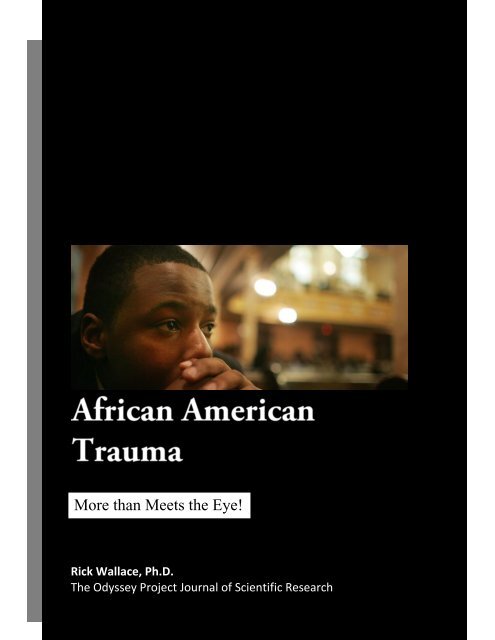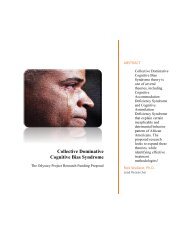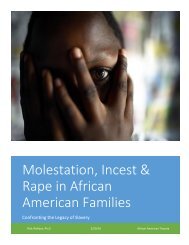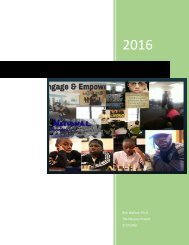African American Trauma: More than Meets the Eye
When I am addressing the current condition of the Black collective in America, and I mention “intergenerational transmission of trauma,” as it is associated with the slavery experience, I will generally meet a nullifidan response. Basically, individuals who do not understand how trauma impacts the body and mind will have a difficult time comprehending how trauma can be transmitted intergenerationally. Hopefully, this short treatise will help!
When I am addressing the current condition of the Black collective in America, and I mention “intergenerational transmission of trauma,” as it is associated with the slavery experience, I will generally meet a nullifidan response. Basically, individuals who do not understand how trauma impacts the body and mind will have a difficult time comprehending how trauma can be transmitted intergenerationally. Hopefully, this short treatise will help!
Create successful ePaper yourself
Turn your PDF publications into a flip-book with our unique Google optimized e-Paper software.
<strong>More</strong> <strong>than</strong> <strong>Meets</strong> <strong>the</strong> <strong>Eye</strong>!<br />
Rick Wallace, Ph.D.<br />
The Odyssey Project Journal of Scientific Research
<strong>African</strong> <strong>American</strong> <strong>Trauma</strong><br />
<strong>More</strong> <strong>than</strong> <strong>Meets</strong> <strong>the</strong> <strong>Eye</strong><br />
By<br />
Dr. Rick Wallace, Ph.D.<br />
Director of Research for The Odyssey Project Scientific Research Journal<br />
Copyright 2016© — Rick Wallace<br />
Page 1 of 7
<strong>African</strong> <strong>American</strong> <strong>Trauma</strong>: <strong>More</strong> <strong>than</strong> <strong>Meets</strong> <strong>the</strong> <strong>Eye</strong><br />
When I am addressing <strong>the</strong> current condition of <strong>the</strong> Black collective in America, and I mention<br />
“intergenerational transmission of trauma,” as it is associated with <strong>the</strong> slavery experience, I will<br />
generally meet a nullifidan response. Basically, individuals who do not understand how trauma<br />
impacts <strong>the</strong> body and mind will have a difficult time comprehending how trauma can be<br />
transmitted intergenerationally.<br />
The average person tends to see a condition, such as Post <strong>Trauma</strong>tic Stress Disorder, as a mental<br />
condition, and <strong>the</strong>y will omit or overlook <strong>the</strong> influence of <strong>the</strong> physiological implications<br />
associated with trauma. The truth is that PTSD is first initiated through a physiological response<br />
to a traumatic event (Kolk B. V., 2014). Additionally, very few people understand <strong>the</strong> impact of<br />
cumulative adversity 1 (Seo, Tsou, Ansell, Potenza, & Sinha, 2013) on a group of people who are<br />
consistently exposed to a wide spectrum of potentially traumatic events. Basically, it is<br />
extremely difficult to heal <strong>the</strong> wounds from trauma when a person is consistently experiencing<br />
new traumatic events.<br />
As technology and <strong>the</strong> understanding of epigenetics increases, we are also learning that <strong>the</strong>re are<br />
genetic influences that have <strong>the</strong> capacity to facilitate <strong>the</strong> transmission of trauma across<br />
generations.<br />
In this brief treatise, I simply want to identify and introduce some of <strong>the</strong> common physiological<br />
responses to trauma, and how <strong>the</strong>y can be transmitted to <strong>the</strong> progeny of <strong>the</strong> person who<br />
experienced <strong>the</strong> trauma.<br />
Because PTSD is such a commonly used term that it is rarely understood in its totality, I will use<br />
it as <strong>the</strong> primary condition to bear out my position on <strong>the</strong> intergenerational transmission of<br />
trauma. It is important to understand that this is not meant to be a comprehensive exploration of<br />
trauma, or its generational perpetuation. I am simply attempting to create <strong>the</strong> foundation on<br />
which those who seek empirical and pragmatic evidence to support <strong>the</strong> idea of generational<br />
trauma will be able to begin <strong>the</strong> process of compiling data and analyzing it.<br />
The first thing that we must do is develop a clear understanding of <strong>the</strong> definition of PTSD, which<br />
is defined by <strong>the</strong> Diagnostics and Statistical Manual 5 as <strong>the</strong> displaying of certain characteristic<br />
symptoms following exposure to one or more traumatic events. Some of <strong>the</strong> characteristics<br />
associated with PTSD include, but are not limited to emotional reactions (including helplessness,<br />
fear and horror), elevated startle response, hypervigilance, problems with concentration, reckless<br />
or self-destructive behavior, sleep disturbance, fear of a foreshortened future, etc. (Staff, 2013).<br />
1<br />
Cumulative Adversity: Cumulative adversity is simply <strong>the</strong> exposure to a wide spectrum of potentially traumatic<br />
events, which can result in ei<strong>the</strong>r depletion — making <strong>the</strong> individual or group more vulnerable to being traumatized,<br />
or it can also foster resilience (Bonnano et al, 2011; Ryff, et al, 2012; Seery et al, 2010)<br />
Page 2 of 7
Something else worth noting concerning PTSD is that <strong>the</strong> person being traumatized does not<br />
have to be directly involved in <strong>the</strong> traumatic event. For instance, <strong>the</strong>re are people who have never<br />
been to New York City who suffer from some level of PTSD as a result of <strong>the</strong> events that<br />
occurred on 9/11. Additionally, susceptibility to traumatic influence depends on a number of<br />
different factors.<br />
One component of <strong>the</strong> PTSD matrix that has always given me cause for concern is <strong>the</strong> high<br />
comorbidity rate associated with PTSD. Individuals who suffer with PTSD are 80 percent more<br />
likely, <strong>than</strong> those without PTSD, to be a victim of a dual-diagnosis, having extraneous symptoms<br />
that meet <strong>the</strong> diagnostic criteria for at least one o<strong>the</strong>r mental disorder (e.g., depressive, anxiety,<br />
substance abuse disorders, bipolar disorder, and more) (Staff, 2013).<br />
Following is a list of physical responses to trauma.<br />
<br />
<br />
<br />
<br />
<br />
<br />
<br />
Sudden sweating and/or heart palpitations (fluttering)<br />
Aches and pains like headaches, backaches, stomach aches<br />
Increased use of alcohol, drugs or overeating (self-medicating)<br />
Constipation or diarrhea<br />
Easily startled by noises or unexpected touch (elevated startle response)<br />
Increased susceptibility to colds, viruses and o<strong>the</strong>r illnesses<br />
Changes in sleep patterns (sleep disruptions), interest in sex and appetite<br />
*Note: Each of <strong>the</strong> above physiological symptoms have <strong>the</strong> capacity to cause harmful secondary<br />
symptoms as well, creating a cascading physical effect.<br />
Here is a small portion of <strong>the</strong> emotional responses to <strong>the</strong> exposure to a traumatic event.<br />
<br />
<br />
<br />
<br />
<br />
<br />
<br />
<br />
<br />
<br />
<br />
Diminished interest in everyday activities or depression<br />
A loss of a sense of order in <strong>the</strong> world; expectation of doom and fear of <strong>the</strong> future<br />
Shock and disbelief<br />
Grief, disorientation, denial<br />
Fear and/or anxiety<br />
Emotional swings — such as crying and <strong>the</strong>n laughing<br />
Irritability, outbursts of anger or rage, restlessness<br />
Worrying or ruminating — intrusive thoughts of <strong>the</strong> trauma<br />
Nightmares<br />
Flashbacks — an experience in which <strong>the</strong> victim reacts as if <strong>the</strong> trauma is happening all<br />
over again<br />
And much more…<br />
(Levin, 2003)<br />
According to Dr. Bessel van der Kolk, arguably <strong>the</strong> foremost expert in trauma experience and<br />
trauma memory, when people who have been traumatized are presented with certain stimuli,<br />
such as sounds, images or thoughts related to <strong>the</strong>ir particular traumatic experience, <strong>the</strong> amygdala<br />
Page 3 of 7
portion of <strong>the</strong> brain reacts with immediate alarm, even when <strong>the</strong> original experience may be 10<br />
or more years in <strong>the</strong> past (Kolk B. V., 2014).<br />
This startled response will trigger a cascade of stress hormones and nerve impulses that can drive<br />
up <strong>the</strong> person’s blood pressure, oxygen intake and heart rate — preparing <strong>the</strong> body for fight,<br />
flight or freeze mode. The problem is that most of <strong>the</strong>se instances in which <strong>the</strong>se stimuli are<br />
presented are not threatening events; however, <strong>the</strong> physical consequences of <strong>the</strong> constant<br />
elevation of stress hormones are real.<br />
Basically, <strong>the</strong>ir body re-experiences rage, terror and helplessness, as well as <strong>the</strong> strong impulse<br />
to fight or flee; however, <strong>the</strong>se feelings are virtually impossible for <strong>the</strong> individual to articulate.<br />
<strong>Trauma</strong>, by nature, pushes a person to <strong>the</strong> edge of cognitive or mental comprehension, separating<br />
<strong>the</strong> person from any language based on common experience.<br />
Shifting to One Side of <strong>the</strong> Brain<br />
For <strong>the</strong> last 30 years, <strong>the</strong>re has been a growing amount of literature that has sensationalized <strong>the</strong><br />
idea of left-brainers (those who function from <strong>the</strong> platform of logic and reason) vs. right-brainers<br />
(those who are more intuitive, creative and artistic). While this idea seemed more novel <strong>than</strong><br />
scientific 30 years ago, <strong>the</strong>re is a growing wealth of empirical data that reveals that <strong>the</strong> left and<br />
right brain speak two different languages — <strong>the</strong> left is linguistic, analytical and sequential, while<br />
<strong>the</strong> right is emotional, intuitive, spatial, visual and tactual. Basically, <strong>the</strong> left side of <strong>the</strong> brain<br />
facilitates <strong>the</strong> ability to speak in a lucid form, and <strong>the</strong> right side houses <strong>the</strong> capacity for<br />
experiential expression, communicating through facial expressions and body language.<br />
In <strong>the</strong> womb, it is <strong>the</strong> right side of <strong>the</strong> brain that develops first, and it actually allows for <strong>the</strong> nonverbal<br />
communication between mo<strong>the</strong>rs and infants. The primary indication that <strong>the</strong> left side of<br />
<strong>the</strong> brain has come on line is when <strong>the</strong> infant begins to understand and respond to verbal<br />
expression.<br />
The manner in which <strong>the</strong> left and right side of <strong>the</strong> brain processes past experiences is<br />
dramatically distinct as well. The left brain has <strong>the</strong> capacity to store and recall facts, statistics and<br />
facts of specific events, allowing us to recall events, while placing <strong>the</strong>m in sequential order. The<br />
right brain stores <strong>the</strong> memories of touch, sound, smell and <strong>the</strong> emotions that <strong>the</strong>se stimuli evoke.<br />
The right brain responds to voices, gestures and facial features, as well as places that have been<br />
experienced in <strong>the</strong> past.<br />
While it has become popular to categorize people as right-brainers or left-brainers, <strong>the</strong> truth is<br />
that under normal conditions, both sides of <strong>the</strong> brain functions synergistically — working<br />
toge<strong>the</strong>r to experience, process, record and recall life experiences. However, having one side of<br />
<strong>the</strong> brain shut down, even temporarily can be extremely disabling. The deactivation of <strong>the</strong> right<br />
side of <strong>the</strong> brain will have an immediate and significant impact on <strong>the</strong> ability to properly<br />
organize and process an experience into logical sequences — making it impossible to effectively<br />
translate <strong>the</strong> experience so that it can be explained. This type of deactivation happens frequently<br />
during traumatic events.<br />
Page 4 of 7
Without proper sequencing, it is impossible for humans to identify cause and effect, comprehend<br />
<strong>the</strong> long-term implications associated with our actions, or create coherent goals and plans for <strong>the</strong><br />
future. This state of reality associated with trauma can explain a substantial part of <strong>the</strong> behavior<br />
of <strong>the</strong> Black collective in general. Now, combine this one psycho-physiological response to<br />
trauma with o<strong>the</strong>r conditions, such as Collective Cognitive Bias Reality Syndrome (Wikipedia,<br />
2014; Wilke & Mata, 2012; Wood, 2016; Wallace, 2015), epigenetic influences on trauma and<br />
traumatic susceptibility, etc. You will begin to understand <strong>the</strong> dilemma we are facing, or should I<br />
say, <strong>the</strong> dilemma we need to face.<br />
The tendency of blacks to ignore or deny <strong>the</strong> presence of certain mental conditions may mask <strong>the</strong><br />
presence of conditions such as PTSD, PTSS, depression and more, but it does not alleviate <strong>the</strong><br />
impact. A substantial portion of our social and economic immobility can be directly linked to <strong>the</strong><br />
existence of trauma. In fact, my work has produced multitudinous occurrences in which <strong>African</strong><br />
<strong>American</strong> trauma was not <strong>the</strong> central focus, but proved highly prevalent in <strong>the</strong> findings.<br />
Simply put, when certain stimuli remind a traumatized individual of <strong>the</strong>ir past experience, <strong>the</strong><br />
right side of <strong>the</strong>ir brain begins to dominate <strong>the</strong> experience, causing <strong>the</strong>m to believe that <strong>the</strong>y are<br />
currently experiencing <strong>the</strong> event. In fact, traumatize people, who are not effectively treated, live<br />
<strong>the</strong>ir entire life through <strong>the</strong> paradigm created by that traumatic event that caused <strong>the</strong>ir trauma.<br />
When a traumatized person has a triggered episode in which <strong>the</strong>y relive <strong>the</strong> experience of <strong>the</strong>ir<br />
trauma, any young children who may be present will sense <strong>the</strong> heighten anxiety, tension, fear and<br />
terror, and while <strong>the</strong>y may not understand why <strong>the</strong> person is behaving that way, <strong>the</strong>y will<br />
develop a tendency to respond <strong>the</strong> same way when <strong>the</strong>y sense that stimuli. In fact, when this<br />
happens, <strong>the</strong> brain’s circuitry will literally rewire itself to instinctively respond to that particular<br />
stimulus <strong>the</strong> same way each time. This is why some people cannot explain what triggered <strong>the</strong>ir<br />
anxiety attacks, because it is a learned behavior that has been passed down without explanation.<br />
Of course, <strong>the</strong> intergenerational transmission of trauma is immensely more complex <strong>than</strong> what is<br />
presented here, but this should be sufficient to provide at least a limited perspicacity of how<br />
easily trauma can be passed down, as well as how trauma tends to perpetuate itself when not met<br />
with direct intervention measures. ~ Dr. Rick Wallace, Ph.D.<br />
Additional Resource by Dr. Wallace:<br />
The Music is Life Program for Youth<br />
The Mis-education of Black Youth in America<br />
<strong>African</strong> <strong>American</strong> Inner-City Violence<br />
The Invisible Fa<strong>the</strong>r: Reversing <strong>the</strong> Curse of a Fa<strong>the</strong>rless Generation<br />
When Your House is Not a Home<br />
Epigenetics in Psychology: The Intergenerational Transmission of <strong>Trauma</strong> in <strong>African</strong> <strong>American</strong>s<br />
Page 5 of 7
Molestation, Incest & Rape in <strong>African</strong> <strong>American</strong> Families<br />
Racial <strong>Trauma</strong> & <strong>African</strong> <strong>American</strong>s<br />
<strong>African</strong> <strong>American</strong>s & Depression: Denying <strong>the</strong> Darkness<br />
The Feminization & Emasculation of <strong>the</strong> Black Male Image<br />
<strong>African</strong> <strong>American</strong> Genocide in America<br />
You can support Dr. Wallace’s work with The Odyssey Project HERE!<br />
Bibliography<br />
Abraham, C. (2014). Transmission of <strong>Trauma</strong> 3. Dublin Business School .<br />
Danieli, Y. (1997). International Handbook of Multigenerational Legacies of <strong>Trauma</strong>. The<br />
National Center for Post-<strong>Trauma</strong>tic Stress Disorder.<br />
DeGruy, J. (2005). Post <strong>Trauma</strong>tic Slave Syndrome: America's Legacy of Enduring Injury and<br />
Healing. Portland, OR: Uptone Press.<br />
Gregoire, C. (2014, December 28). How <strong>the</strong> Effects of <strong>Trauma</strong> Can be Passed Down From One<br />
Generation to <strong>the</strong> Next. Huffington Post.<br />
Kardiner, A. (1941). The <strong>Trauma</strong>tic Neurosis of War. New York: Hoeber.<br />
Kolk, B. A. (2001). Exploring <strong>the</strong> Nature of <strong>Trauma</strong>tic Memory: Combining Clinical Knowledge<br />
with Laboratory Methods. <strong>Trauma</strong> and Cognitive Science Haworth Press, Inc.<br />
Kolk, B. V. (1987). Psychological <strong>Trauma</strong>. <strong>American</strong> Psychiatric Press.<br />
Kolk, B. V. (2014). The Body Keeps <strong>the</strong> Score. New York: Penguin Publishers.<br />
Levin, P. (2003). Common Responses to <strong>Trauma</strong> — and Coping Strategies. Levin Journa of<br />
Pyschological Disorders.<br />
Lloyd, D. A., & Turner, R. J. (2003). Cumulative Adversity and Postraumatic Stress Disorder:<br />
Evidence From a Diverse Community Sample of Adults. <strong>American</strong> Journal of<br />
Orthopsychiatry.<br />
Mullan-Gonzalez, J. (2012). Slavery and <strong>the</strong> Intergenerational Transmission of <strong>Trauma</strong> in Inner<br />
City <strong>African</strong> <strong>American</strong> Male Youth: A Model Program—from <strong>the</strong> Cotton Fields to <strong>the</strong><br />
Concrete Jungle. California Institute of Integral Studies.<br />
Page 6 of 7
Seo, D., Tsou, K., Ansell, E., Potenza, M., & Sinha, R. (2013). Cumulative Adversity sensitizes<br />
neural response to acute stress: Association with Health Symptoms. National Institutes of<br />
Health.<br />
Staff, E. (2013). DSM-5. <strong>American</strong> Psychiatric Publishing.<br />
Wallace, R. (2015). Collective Cognitive-bias Reality Syndrome. The Odyssey Project Journal<br />
of Research and Cognitive Enrichment!<br />
Wallace, R. (2015). Epigenetics in Psychology: The Genetic Intergenerational Transmission of<br />
<strong>Trauma</strong> in <strong>African</strong> <strong>American</strong>s. The Rick Wallace Social Research & Cognitive<br />
Enrichment Institute.<br />
Wikipedia. (2014, April 15). Cognitive Bias. Retrieved from Wikipedia:<br />
https://en.wikipedia.org/wiki/Cognitive_bias<br />
Wilke, A., & Mata, R. (2012). Cognitive Bias. Encyclopedia of Human Behavior.<br />
Wood, J. M. (2016). 20 Cognitive Bias that Affect Your Decisions. Mental Floss.<br />
Ximena, F., & Ximena, G. (2015). Pyshcological <strong>Trauma</strong> Transmission and Appropriation in<br />
Grandchildren of Former Political Prisoners of <strong>the</strong> Civic - Military Dictatorship in Chile<br />
(1973-1990). Journal of social Science Education.<br />
Page 7 of 7

















